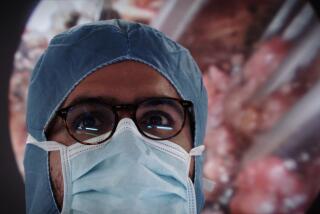First, Da Vinci decoded anatomy
- Share via
Among the clues in “The Da Vinci Code,” in a cameo of sorts, is “Vitruvian Man.” The drawing depicts the body’s perfect geometry and is likely the most widely recognized anatomical sketch of all time. But it’s just one of hundreds of anatomy sketches that the artist Leonardo da Vinci created.
-- Elena Conis
*
As a budding artist apprenticed in a busy painter’s guild at age 15, Da Vinci was forced to study anatomy to get his depictions of the human body right. He proved so adept at transferring the human figure to the canvas that he soon received permission to study bodies at a local morgue.
Because the medical profession, for the most part, had not yet deemed gross anatomy critical to the study of medicine, Da Vinci often had the bodies to himself.
Over the course of his career, Da Vinci dissected 30 corpses in the cramped dark quarters of hospital basements in Florence, Rome and Milan. He was forced to work quickly. There were no preservatives for bodies, and corpses would decay at a rapid clip.
His long dark hours in the crypts paid off. Da Vinci was the first to draw the bones of the hands and face correctly, as well as the curve of the backbone. He proved the heart was a muscle with four chambers, not a mere two. He drew varied views of the skull and cross-sections of the brain (which he dubbed one of the body’s “motors”), and was one of the first to depict what the fetus looked like inside the womb -- though he drew the curled figure inside the uterus of a cow. (Like some ancient Greek philosophers, he believed human and animal organs were interchangeable.)
Da Vinci painstakingly drew the trachea, larynx and pharynx; muscles of the arms, legs and back, layer by layer; and bones individually and in relation to other bones. Da Vinci also attempted to figure out how things worked. His drawings show that he deduced how the vocal chords produce sound and how the heart’s valves direct the flow of blood.
He wasn’t always correct. He somehow concluded that blood was consumed by muscles and that semen originated in the brain.
Most incredible, though, is how much the Renaissance artist, anatomist and inventor got right -- and the fact that he continues to this day to inspire not just artists, filmmakers and writers, but also doctors. A new surgical robot, used to perform surgeries through just a few tiny incisions, has been named for him. In 2001, a bridge based on one of his designs was erected in Norway. And in 2005, a British surgeon developed a new way to repair the heart’s mitral valve after being inspired by his accurately detailed and by-then-500-year-old sketches of the heart.
More to Read
The biggest entertainment stories
Get our big stories about Hollywood, film, television, music, arts, culture and more right in your inbox as soon as they publish.
You may occasionally receive promotional content from the Los Angeles Times.










